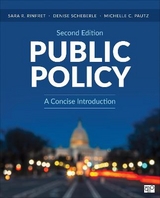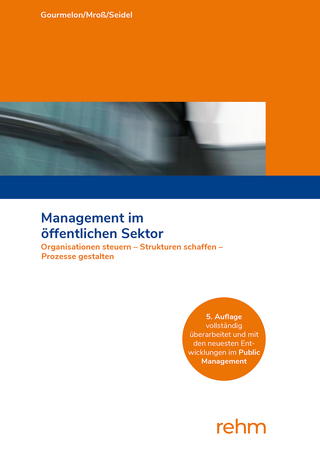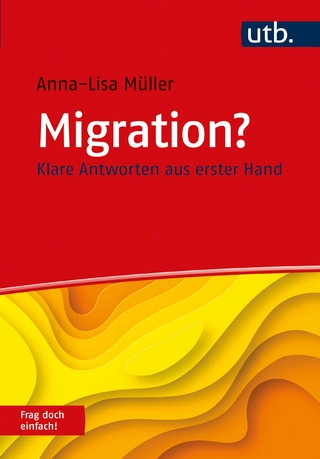
Public Policy
Cq Press (Verlag)
978-1-5063-2971-0 (ISBN)
- Titel erscheint in neuer Auflage
- Artikel merken
Dr. Sara R. Rinfret is currently a Professor of Public Administration and Associate Vice Provost of Faculty Affairs at Northern Arizona University. She has more than a decade of higher education administrative experience and is a nationally recognized scholar in regulatory policy, environmental policy, and public administration. She previously served as the Acting Dean for the Alexander Blewett School of Law, Chair of the Department of Public Administration and Policy, and the Director of Master of Public Administration at the University of Montana. To date, she has published 8 books and more than 40 peer reviewed articles, and several book chapters. She is the recipient of the Fulbright Specialist Program in public administration and studied with scholars at the University of Aarhus (Denmark, 2016). She holds an MPA from the John Glenn College of Public Affairs (Ohio State), and PhD in political science from Northern Arizona University. Denise Scheberle is a clinical teaching professor for the School of Public Affairs at the University of Colorado– Denver. She is Professor Emerita from the University of Wisconsin–Green Bay,where she served as the Herbert Fisk Johnson Professor in Environmental Studies and professor and chair of the Department of Public and Environmental Affairs. She is the recipient of national, state, and campus teaching awards, including the American Political Science Association’s (APSA) Distinguished Teaching Award and University of Wisconsin Regents Teaching Excellence Award. She is the author of Industrial Disastersand Environmental Policy: Stories of Villains, Heroes, and the Rest of Us and Federalism and Environmental Policy: Trust and the Politics of Administration, as well as numerous articles. Her research focuses on environmental policy, public service, and intergovernmental relations. She holds a PhD in political science from Colorado State University and an MPA from the University of Wyoming. Michelle C. Pautz is professor of political science and assistant provost of the Common Academic Program at the University of Dayton. Her research has appeared in Administration & Society, Administrative Theory & Praxis, Journal of Political Science Education, Journal of Environmental Studies & Sciences, Journal of Public Affairs Education, Policy Studies Journal, PS: Political Science & Politics, Public Voices, and the Review of Policy Research, among others. She is the author of Civil Servants on the Silver Screen: Hollywood’s Depiction of Government and Bureaucrats; coauthor of The Lilliputians of Environmental Regulation: The Perspective of State Regulators and U.S. Environmental Policy in Action: Practice & Implementation (now in its second edition), both with Sara Rinfret; and coeditor of Administering the U.S. Food System: Revisiting Food Policy and Politics. She is the recipient of the University of Dayton’s Alumni Award for Faculty Teaching in 2016. She holds a PhD in public administration and an MPA from Virginia Tech. She earned a BA in economics, political science, and public administration from Elon University.
List of Figures and Tables
Preface
Acknowledgments
About the Authors
SECTION I: DEFINING U.S. PUBLIC POLICYMAKING
CHAPTER ONE: The Foundation
Learning Objectives
Opening Vignette: Public Policy and Our Everyday Lives
Starting with a Definition
Power and Politics
A Federal System
Categories of Public Policy
The Process
A Motley Crew: Institutional and Noninstitutional Actors
The Three Branches of Government
The Implementers
The Media, Interest Groups, and Us
Shaping Policy
What about Us?
Policy Analysis
Policy Evaluation
Why Studying Public Policy Matters
Plan of the Book
Concluding Thoughts
Glossary Terms
Discussion Questions
Suggested Resources
Notes
CHAPTER TWO: The Policy Process and Policy Theories
Learning Objectives
Opening Vignette: Policy Rhetoric and Reality
What Really Is Policy?
Understanding the Context of Public Policy
The Political Environment
The Economic Environment
The Social and Cultural Environment
The Administrative Environment
The Quest for Public Policy Theory
The Stages Heuristic Model of Public Policymaking
Sugary Drinks
Stage 1: Problem Identification and Definition
Stage 2: Agenda Setting
Stage 3: Policy Formulation
Stage 4: Policy Legitimation
Stage 5: Policy Implementation
Stage 6: Policy Evaluation
Assessing the Stages Model
Alternative Policy Process Models
Multiple Streams Framework
Pros and Cons of the MSF
Punctuated Equilibrium
Actors in the Policy Process
Concluding Thoughts
Glossary Terms
Discussion Questions
Suggested Resources
SECTION II: THE PRACTICE OF PUBLIC POLICY
CHAPTER THREE: Federalism and Intergovernmental Relations
Learning Objectives
Opening Vignette: Up in Smoke: Federal and State Marijuana Policies Collide
Telling Stories with Data: Using Gallup Polling Data to Detect Trends
Overview of Federalism and Intergovernmental Relations
National Policymaking Constrained under the Articles of Confederation
Constitutional Foundation of Federalism
Intergovernmental Relations
Federalism and Intergovernmental Relations Evolve
Dual Federalism
Cooperative Federalism
Creative Federalism
Federalism and Intergovernmental Relations Today
Underfunded and Unfunded Mandates
Building Picket Fences
Increasing Capacity of State and Local Governments
Differences in State Cultures, Politics, Economies, and Events
Enduring Virtues of a Federal System
Safeguards Individual Rights and Democracy
Promotes Responsibility
Stimulates Innovation
Increases Efficiency and Effectiveness in Policy Implementation
Everyday Citizen Connection
Concluding Thoughts
Glossary Terms
Discussion Questions
Suggested Resources
CHAPTER FOUR: Rulemaking and Regulations
Learning Objectives
Opening Vignette: From Peanuts on a Plane to the Future of E-Cigarettes
Understanding the Context of U.S. Regulations
Defining Regulatory Policy
Delegation of Authority
Why Delegate?
Congress and Accountability
The President and Accountability
The Supreme Court and Accountability
Understanding Regulatory Processes
State Rulemaking
Influence and Participation
After a Rule Becomes a Law
Regulating Your Local Dry Cleaner
The Good, the Bad, and the Ugly
The Future of Regulatory Policy
Everyday Citizen Connection
Concluding Thoughts
Glossary Terms
Discussion Questions
Suggested Resources
Notes
SECTION III: UNDERSTANDING KEY PUBLIC POLICY ISSUES
CHAPTER FIVE: Economic Policy and Public Budgeting
Learning Objectives
Opening Vignette: Green Eggs and Ham and the Federal Government Shutdown in 2013
Overview of Economic Policy and Public Budgeting
Types of Economies and Economic Policy Definition Economic Theories
Size and Scope of the U.S. Economy
Public Opinion and the Economy
Telling Stories with Data: Using The Bureau of Labor Statistics to Explore Regional Economic Data
Monetary and Fiscal Policy
The Federal Budget
Budget Process
Government Revenues and Expenditures
Revenues
Expenditures
Debt and Deficit
History and Development of Economic Policy
Founding Period
Growth of Government Spending
Great Recession and Government Response
Major Economic Policy and Budgeting Statutes
Major Actors in Economic Policy
Congress
President
Government Agencies
Issues and Challenges
Political Polarization
Debts and Deficits
Global Markets and Free Trade
Everyday Citizen Connection
Concluding Thoughts
Policy Choices: The Federal Tax System
Policy Choices: Federal Tax Policy
Glossary Terms
Discussion Questions
Suggested Resources
CHAPTER SIX: Crime and Public Policy
Learning Objectives
Opening Vignette: Guns on Campus: Safety or Risk?
Overview of Crime in America
Types of Crime
The U.S. Crime Rate
Explaining Decreases in the U.S. Crime Rate
Public Perceptions about Crime
The U.S. Incarceration Rate
History and Development
Federalizing Crime
Public Attitudes about the Incidence of Crime
Media and Crime
Actors in Criminal Justice Policy
Federal Law Enforcement Agencies
State and Local Law Enforcement Agencies
Federal and State Courts
Crime Victims
Probation Officers and Parole Officers
Major U.S. Criminal Justice and Crime Policy Statutes
Capital Punishment
Issues and Challenges
Deterrence and Recidivism
Telling Stories with Data: The Death Penalty
Crime and Race
Juvenile Crime
Mass Shootings
Everyday Citizen Connection
Policy Choices: Gun Control
Concluding Thoughts
Glossary Terms
Discussion Questions
Suggested Resources
CHAPTER SEVEN: Education Policy
Learning Objectives
Opening Vignette: Behind the Curtain of a Public Education
Overview of U.S. Education Policy
Understanding the Structure of a U.S. Education Status and Scope
Telling Stories with Data: Using Maps to Explore Education Funding
History and Development of the U.S. Education System
Colonialism and Mann
Challenges and Change
Choice and a Digital Revolution
Major Education Policy Statutes
Major U.S. Education Laws
Major Actors in U.S. Education Policy
President
Congress
Courts
Bureaucracy
State Actors and Vested Interests
Governors and State Legislatures
State Expertise
Mayors, Superintendents, and Teachers
Interest Groups
What’s for Lunch?
Issues and Challenges
Paradigm Shift
Curriculum and Technology
Connecting the Dots
New Narrative
Everyday Citizen Connection
Concluding Thoughts
Policy Choices: Student Evaluation
Glossary Terms
Discussion Questions
Suggested Resources
CHAPTER EIGHT: Civil Rights and Immigration Policy
Learning Objectives
Opening Vignette: The Desert and an Elusive Cat
Overview of Civil Rights
Civil Rights and Immigration
Status and Scope
Longitudinal Trends
Public Opinion Research
Immigration Sentiments
Telling Stories with Data: Using Gallup Polling Data to Detect Trends
History and Development of U.S. Immigration Policy
National Origin Quotas
Civil Rights, Amnesty, and Enforcement
9/11, Dreamers, and Deportation
Major U.S. Immigration Policy Statutes
Select Major U.S. Immigration Laws
The Actors in Immigration Policy
President
Congress
Courts
Bureaucracy
Unofficial Actors in Immigration Policy
States
The Immigration Posse and the ACLU
Issues and Challenges
Security and Crime
Sanctuary Cities and Refugees
Small Town USA
Everyday Citizen Connection
Concluding Thoughts
Policy Choices: Immigration Reform
Glossary Terms
Discussion Questions
Suggested Resources
Notes
CHAPTER NINE: Social Welfare and Health Care Policy
Learning Objectives
Opening Vignette: Living on $2 a Day
Overview of Social Welfare Policy
Defining Poverty
Who Is Poor?
Telling Stories with Data: Using Census Data
Public Values and Types of Social Welfare Programs
Public Support for Social Welfare Programs
History and Development of U.S. Social Welfare Policy
Poor Houses and “Outdoor Relief”
The New Deal and Social Security
Unemployment Insurance and AFDC
The Great Society and Connecting Health Care to Social Welfare
Welfare Reform through TANF
Overview of Health Care Policy
Government-Run Insurance Programs: Medicare, Medicaid, and CHIP
The Affordable Care Act and Beyond
Key Provisions of the ACA
History and Development of U.S. Health Care Policy
Early Efforts to Establish Health Care
Health Reform Efforts after the Great Depression
The 1960s through 2017: Government Steps In
ACA Repeal Attempts under President Trump
Major U.S. Social Welfare and Health Care Statutes
Select Major U.S. Social Welfare and Health Care Laws
Major Actors in Social Welfare and Health Care Policy
The President
Congress
Courts
Federal Bureaucracies
State Governments
Unofficial Actors
Issues and Challenges
Income Inequality
The High Health Cost of Being Poor
Universal Health Care Coverage and Single-Payer Health Care
Everyday Citizen Connection
Concluding Thoughts
Policy Choices: Social and Welfare Policy—Family Leave
Glossary Terms
Discussion Questions
Suggested Resources
CHAPTER TEN: Environmental and Energy Policy
Learning Objectives
Opening Vignette: A Web of Actors When Disaster Strikes
Overview of Environmental and Energy Policy
Understanding U.S. Environmental Policy
Status and Scope
Telling Stories with Data: Using U.S. Epa Air Quality Trends Data
History and Development of Environmental Policy
Birth of the Modern Environmental Movement (1960s and 1970s)
Changing Course (1980s)
Diffused Attention in the 1990s and Early 2000s
Executive Action in the 2010s
Understanding U.S. Energy Policy
Status and Scope
History and Development of Energy Policy
Crisis in the 1970s
Deregulation in the 1980s
Toward a Comprehensive Energy Policy in the 1990s
Energy and National Security Concerns in the 2000s
Major Environmental and Energy Policy Statutes
Major Actors in Environmental and Energy Policy
Congress
President
Federal Courts
Executive Agencies
Interest Groups and Lobbyists
Greenhouse Gases Go to Court
Issues and Challenges
Lack of a Coherent, Cohesive Policy
Politicization
Role of Science in Policy Debates
Trade-offs between the Environment and the Economy
The Commons
Everyday Citizen Connection
Concluding Thoughts
Policy Choices: Nonpoint Source Pollution
Policy Choices Reflection Questions
Policy Choices: Nonpoint Source Water Pollution
Glossary Terms
Discussion Questions
Suggested Resources
CONCLUSION: Public Policy: A Concise Introduction
Learning Objectives
Opening Vignette: On the Front Lines
Putting the Pieces Together
A Dynamic Enterprise
Why Public Policy Matters
Public Problems and Solutions
Finding the Facts
Consensus and Public Policy
Concluding Thoughts
Glossary Terms
Discussion Questions
Suggested Resources
Glossary
References
Index
| Erscheinungsdatum | 18.09.2018 |
|---|---|
| Verlagsort | Washington |
| Sprache | englisch |
| Maße | 187 x 231 mm |
| Gewicht | 570 g |
| Themenwelt | Sozialwissenschaften ► Politik / Verwaltung ► Staat / Verwaltung |
| ISBN-10 | 1-5063-2971-3 / 1506329713 |
| ISBN-13 | 978-1-5063-2971-0 / 9781506329710 |
| Zustand | Neuware |
| Haben Sie eine Frage zum Produkt? |
aus dem Bereich



